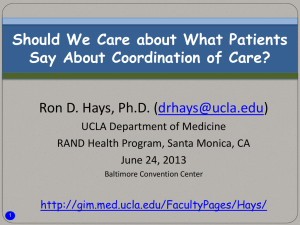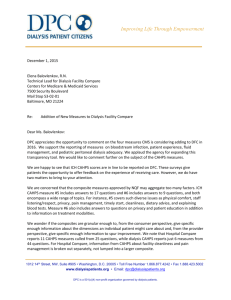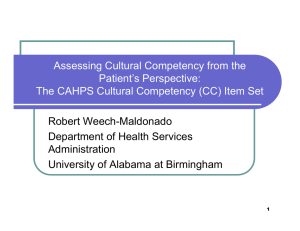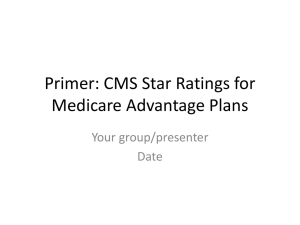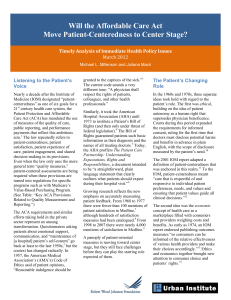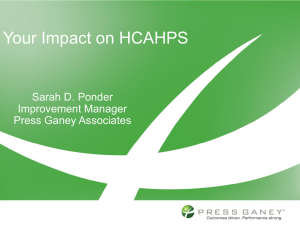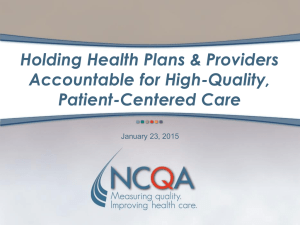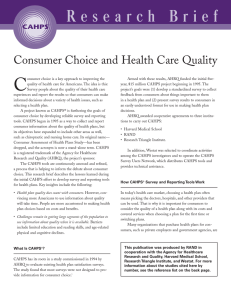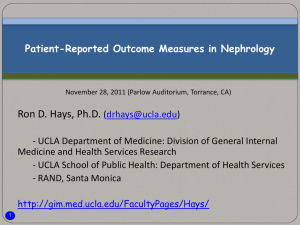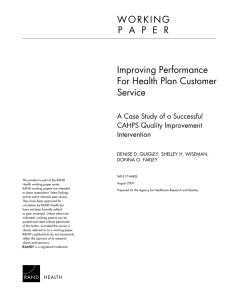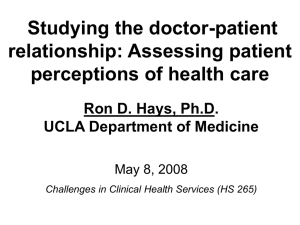A Parsimonious Patient-Reported Measure of Care
advertisement
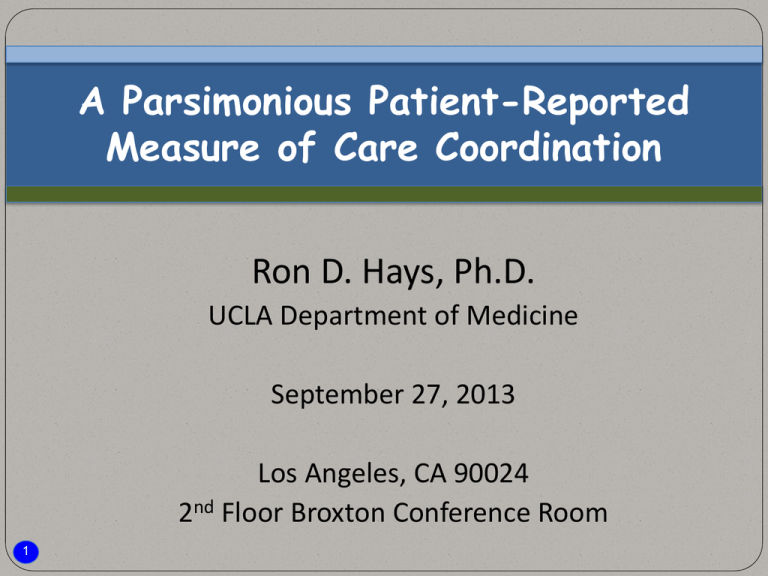
A Parsimonious Patient-Reported Measure of Care Coordination Ron D. Hays, Ph.D. UCLA Department of Medicine September 27, 2013 Los Angeles, CA 90024 2nd Floor Broxton Conference Room 1 Consumer Assessment of Healthcare Providers and Systems (CAHPS®) Project U18 HS016980 Consortium 2 Collaborators • RAND – Steven Martino, Julie A. Brown, Mike Cui, Marc Elliott • Yale – Paul Cleary • Center for Medicare & Medicaid Services (CMS) – Sarah Gaillot • Supported by – CMS contract HHSM-500-2005-000281 3 We Measure Quality of Care to Improve It 4 Providers Find out how well they are doing Government/ Private Insurers Identify best/worst healthcare providers Patients Choose best health care for themselves How Do We Measure Quality of Care? • Focus has been on expert consensus • Variant of RAND Delphi Method 5 How Do We Measure Quality of Care? • But how patients perceive their care also important • CAHPS project was tasked with measuring patient experiences. • Focus has been on expert consensus • Variant of RAND Delphi Method 6 7 CAHPS Approach Complements information from clinical process measures • Focus on what patients want to know about AND can accurately report about 8 – Communication with health care provider – Access to care – Office staff courtesy and respect – Customer service Correlates positively with clinical measures, but important in own right Rather than Assessing Patient Satisfaction, CAHPS Relies on Reports About Care 9 CAHPS Medicare Survey Composites Communication (4 items) Getting needed care (2 items) Getting care quickly (3 items) Customer Service (3 items) 10 CAHPS Has Evolved Over Time 1995 2013 CAHPS I (1995–2001) CAHPS II (2002–2007) CAHPS III (2007–2012) CAHPS IV (2012–2017) • Develop surveys • Enhance reporting guidelines and advance science of reporting • Evaluating quality Improvement efforts CAHPS I–IV represent $26 million in total funding 11 CAHPS Now Has a Family of Surveys Ambulatory Care 12 Health Plan Survey Clinician & Group Survey Home Health Care Survey Surgical Care Survey ECHO® Survey Dental Plan Survey American Indian Survey CAHPS Now Has a Family of Surveys Ambulatory Care Health Plan Survey Clinician & Group Survey Home Health Care Survey Surgical Care Survey ECHO® Survey Dental Plan Survey American Indian Survey Facility Hospital Survey In-Center Hemodialysis Survey Nursing Home Survey 13 CAHPS Now Has a Family of Surveys Ambulatory Care Health Plan Survey Clinician & Group Survey Home Health Care Survey Surgical Care Survey ECHO® Survey Dental Plan Survey American Indian Survey Facility Hospital Survey In-Center Hemodialysis Survey Nursing Home Surveys 14 CAHPS undisputed leader in measuring patient experience Care Coordination Measures • McDonald, K. M., et al. Care coordination measures atlas version 3. AHRQ, 2010. • David Meyers, AHRQ • CAHPS PCMH survey (Scholle et al., 2012) – Availability of test results and records during appointments – Information about prescription medicines – Communication among providers 15 CAHPS Medicare Survey 2012 Care Coordination Items Personal doctor: 1. has medical records or other information about your care during visits 2. talks about all medicines you are taking 3. informed and up-to-date about care from specialists 4. helps manage care from providers and services 5. follows up on test results 16 Data Collection • Random sample of 2012 Medicare beneficiaries – Data collected from February 21 to May 29, 2012 – 46% response rate • 266,466 in analytic sample – 98,014 fee-for service beneficiaries – 168,452 Medicare Advantage plan members 17 Analyses • Categorical confirmatory factor analysis (Mplus) – Patient-level and multi-level (patient and MA plan) – Comparative Fit Index (CFI) > 0.95 – Root Mean Square Error of Approximation (RMSEA) < 0.06 • Reliability >= 0.70 – Internal consistency (coefficient alpha) – Plan-level reliability 18 CAHPS Medicare Survey Composites Communication (4 items) Getting care quickly (3 items) Getting needed care (2 items) Customer Service (3 items) 19 Regress Global Rating on Composites Using any number from 0 to 10, where 0 is the worst personal doctor possible, and 10 is the best personal doctor possible, what number would you use to rate your personal doctor? 20 0 Worst personal doctor possible 1 2 3 4 5 6 7 8 9 10 Best personal doctor possible Confirmatory Factor Analyses • Good fit for patient-level CFA – CFI = 0.996 – RMSEA = 0.020 • Good fit for multi-level CFA – CFI = 0.997 – RMSEA = 0.014 21 Standardized Factor Loadings Within-Level Between-Level Has medical records 0.72 (0.71) 0.86 Talks about medicines 0.65 (0.64) 0.58 Informed and up-to-date 0.70 (0.69) 0.49 Helps manage care 0.71 (0.77) 0.97 Follow-up on test results 0.71 (0.70) 0.72 Loadings from patient-level CFA shown within parentheses. Multi-level CFA loadings are the other numbers. 22 Reliability • Internal consistency (alpha) = 0.70 • Plan-level – ICC = 0.022 at plan level – Number of patients needed to obtain 0.70 reliability = 102 0.80 reliability = 170 23 Regression of Global Rating of Personal Doctor on CAHPS Composites Composite Communication 0.62 Care Coordination 0.17 Getting Care Quickly 0.04 Getting Needed Care 0.01 Customer Service -.002 (ns) (R 2 24 Standardized Beta = 0.56) 24 Conclusions • Care coordination composite – Unidimensional – Has satisfactory reliability – Uniquely associated with global rating of personal doctor • Implications for CMS – Report to patients – Report to plans – Use in Quality Bonus Payments to Managed Care Plans • http://www.cms.gov/Medicare/Prescription-DrugCoverage/PrescriptionDrugCovGenIn/PerformanceData.html • Outcomes (55%), CAHPS (27%), Process (18%) • Future 25 – Examine how it is related to other ways of assessing care coordination such as work flow, scheduling and documentation rated by external observers. Thank you. Medical Care Research & Review, in press drhays@ucla.edu Chuck Darby, Emeritus CAHPS Project Officer 26 26
